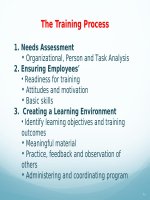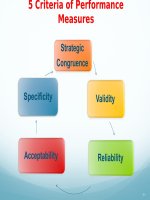Lecture Human resource management: Gaining a competitive advantage (9/e) – Chapter 7: Training
Bạn đang xem bản rút gọn của tài liệu. Xem và tải ngay bản đầy đủ của tài liệu tại đây (943.94 KB, 11 trang )
Chapter 7
Training
Copyright © 2015 McGrawHill Education. All rights reserved. No reproduction or distribution without the prior written consent of McGrawHill Education.
Key Features of Continuous Training
72
Training Process
73
Needs Assessment Process
What is the content?
Who needs training?
In what do they
need training?
74
3 Factors to Choose Training
SupportManager and Peers
75
5 Factors That Influence
Employee Performance and Learning
76
Factors That Influence Motivation to Learn
77
Selecting Training Methods
Presentation Methods
Instructor-led classroom instruction
Distance learning, teleconferencing & webcasting
Audiovisual techniques
Mobile technology
Hands-on Methods
On-the-job training, apprenticeships and internships
Self-directed learning
Simulations, avatars
Business games and case studies
Behavior modeling
E-learning
Social media
Blended learning
Learning management system (LMS)
Group or Team Building
Experiential programs
Cross, coordination and team training
Action and adventure learning
78
Determining Return on Investment
(ROI)
79
Cross-Cultural Preparation
Expatriate - is an employee sent by a company to
manage operations in a different country.
Expatriates need to be:
1. Competent in their area of expertise.
2. Able to communicate verbally and nonverbally in host
country.
3. Flexible, tolerant of ambiguity and sensitive to cultural
differences.
4. Motivated to succeed, able to enjoy the challenge of
working in other countries, and willing to learn about
the host country’s culture, language and customs.
5. Supported by their families.
710
Summary
Technological innovations, new product markets, and a
diverse workforce have increased the need for
companies to reexamine how their training practices
contribute to learning.
Training can contribute to effectiveness through
establishing a link with the company’s strategic direction
and demonstrating through cost–benefit analysis how
training contributes to profitability.
The key to successful training is choosing the most
effective training method.
Managing diversity and cross-cultural preparation are
two training issues relevant to capitalize on a diverse
workforce and global markets.
711









